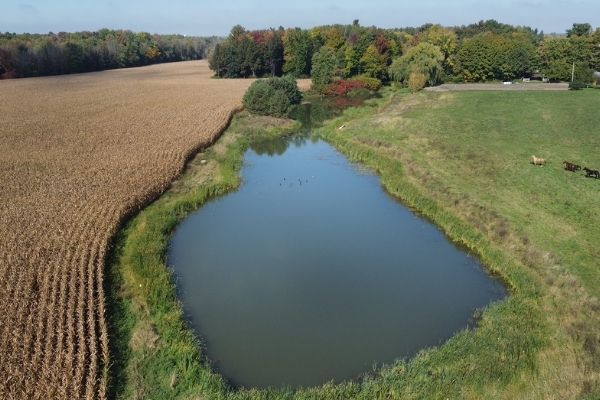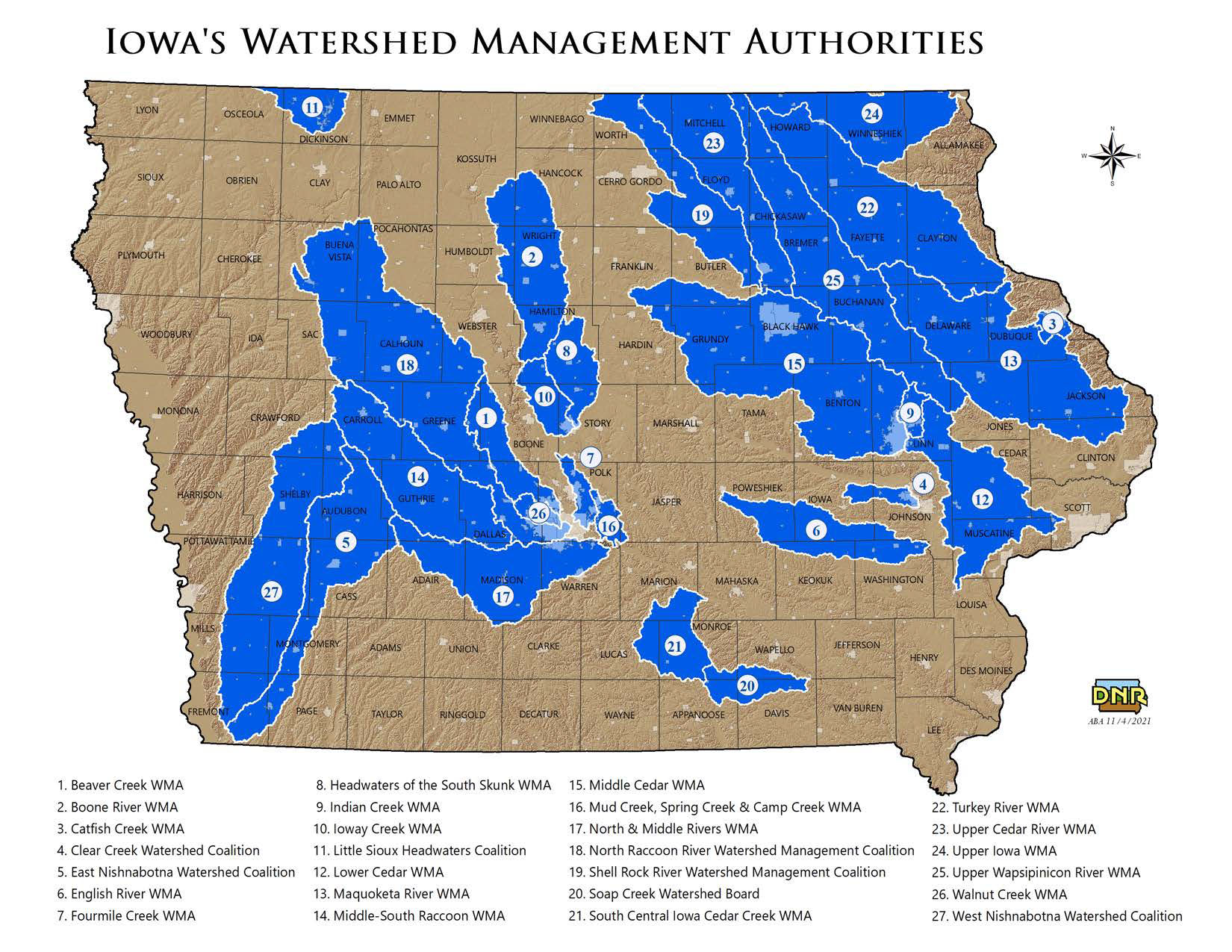46 Iowa’s Approaches to Improving Water Quality
The Iowa Nutrient Reduction Strategy (NRS):
The Iowa Nutrient Reduction Strategy (NRS) is a collaborative, science-based initiative designed to reduce the amount of nitrogen and phosphorus entering Iowa’s waterways, as well as the Mississippi River and the Gulf of America. The NRS was developed by the Iowa Department of Agriculture and Land Stewardship (IDALS), the Iowa Department of Natural Resources (DNR), and Iowa State University. Released in 2013 and continually updated, the NRS emphasizes voluntary practices over regulatory mandates, aiming to engage farmers, municipalities, and industry in collective nutrient reduction efforts (“Iowa Nutrient Reduction Strategy”). The NRS addresses both point sources, such as wastewater treatment plants, and nonpoint sources, mainly agricultural runoff. Point sources are regulated through the NPDES of the Clean Water Act, as described previously, and encouraged to adopt enhanced treatment technologies to remove nutrients before discharge. Meanwhile, nonpoint sources rely on best management practices (BMPs) for the removal and reduction of nutrients in water sources. Best management practices are practical, science-based methods or techniques used to control the amount of pollution that enters bodies of water. BMPs specifically aim to protect water quality, reduce soil erosion and enhance soil health, and improve environmental sustainability. In Iowa, some examples of best management practices are cover crops, conservation tillage, nutrient management planning, and wetland restoration (Iowa State University). The image on the right shows a constructed wetland next to a cornfield, which is an example of a Best Management Practice (BMP) promoted by Iowa’s Nutrient Reduction Strategy (NRS). These wetlands are designed to capture and filter runoff from agricultural fields before it can reach nearby water bodies. By slowing the flow of water and allowing sediments and nutrients like nitrogen and phosphorus to settle or be absorbed by vegetation, wetlands significantly reduce the amount of pollution entering Iowa’s streams and rivers. This photo illustrates how BMPs are integrated

directly into the landscape, helping farmers protect water quality while maintaining a functional and productive farmland. Wetland restoration projects like this one are supported by state agencies and research institutions as part of a broader effort to address nutrient pollution in both local waterways and the Gulf of Mexico. While these tools are widely supported by science, critics argue that the voluntary nature of the NRS and best management practices reduces its effectiveness in achieving long-term water quality improvements, especially when there are no mandatory timelines or penalties for non-compliance. Despite these concerns, Iowa’s NRS aligns with larger efforts across the Mississippi River Basin, including those led by the Mississippi River/Gulf of Mexico Watershed Nutrient Task Force, which seeks to address hypoxia in the Gulf of Mexico. The Gulf suffers from a “dead zone” each summer caused by excess nutrients that trigger massive algal blooms, depleting oxygen in the water (Iowa State University). Research has proven that Iowa and its’ agricultural presence is a major contributor to the pollution in the Gulf, leading to the promotion and awareness of policies and how to control Iowa’s nutrient emissions. Research and monitoring continue to guide the strategy. Iowa State University plays a critical role in tracking nutrient reduction performance and modeling outcomes to estimate nutrient loss reductions across the state (Iowa State University). While significant progress has been made in farmer education and adoption of conservation practices, like best management practices, further collaboration and long-term investment will be key to achieving the strategy’s ambitious goals.
The Iowa Watershed Approach:
The Iowa Watershed Approach (IWA) is a forward-thinking initiative that began in 2016 with nearly $97 million in funding from the U.S. Department of Housing and Urban Development (HUD). It was created in response to the increasing frequency and intensity of flooding events across Iowa and the Midwest. The IWA focuses on improving flood resilience, water quality, and habitat across nine Iowa watersheds through nature-based and community-driven solutions. One of the most important parts of the IWA is the formation of Watershed Management Authorities (WMAs). These are voluntary, locally led partnerships of cities, counties, and soil and water conservation districts that develop and implement watershed plans. The map on the right illustrates the network of Watershed Management Authorities (WMAs) across the state of Iowa. Each blue-highlighted region represents a locally organized WMA participating in the Iowa Watershed Approach (IWA).

These WMAs bring together cities, counties, and conservation districts to develop and implement watershed plans that address flooding, water quality, and ecological health. This map shows the broad geographic coverage of the IWA, showing how watershed-based collaboration extends from the more urban areas of eastern Iowa to rural, agriculturally dominated areas in the farther west parts of Iowa. It also emphasizes the local, grassroots nature of Iowa’s water management strategy—one in which communities take ownership of their water resources through science-based, place-specific action. The IWA supports WMAs with resources for hydrological modeling, technical assistance, and project funding (Iowa Watershed Approach).

The projects supported by IWA include wetland restoration, oxbow lake reconstructions, retention basins, and floodplain reconnection. All of these projects are natural infrastructure that not only reduce the risk of flooding but also improve water quality by slowing and filtering runoff from agriculture and urban streams. According to a report from the University of Iowa, by the end of 2024, the IWA had helped complete over 800 such structures. Apart from building and developing natural infrastructure, the IWA focuses on education and public outreach. Residents of communities are engaged through workshops and meetings, and many WMAs include citizen advisory boards. The education and awareness approach ensures that landowners and local leaders are invested in the health of their watersheds. The IWA is a model of integrated watershed management that combines science, funding, and community engagement to produce measurable and quantifiable outcomes.
The Iowa Stormwater Management Program:
Urban development dramatically increases disruptive surfaces like streets and parking lots, which disrupts the natural water cycle by accelerating stormwater runoff and sending runoff to different locations. Stormwater runoff is meant to return to soil, but due to urban construction, runoff travels rapidly over surfaces, collecting pollutants like oil, heavy metals, nutrients, and sediment, which are then discharged into rivers and lakes. The Iowa Stormwater Management Program was created to regulate and reduce the effects of stormwater on water quality, flooding, and erosion. The Iowa Stormwater Management program operates under federal authority through the National Pollutant Discharge Elimination System (NPDES), as established by the Clean Water Act (U.S. EPA, “NPDES”). It requires cities and construction sites to obtain permits to regulate stormwater discharges and mitigate environmental damage (U.S. EPA, “NPDES”). The program relies heavily on design standards and techniques outlined in the Iowa Stormwater Management Manual. This manual emphasizes the use of Low Impact Development (LID) practices, such as bioswales, permeable pavement, rain gardens, vegetated swales, green roofs, and stormwater wetlands (Iowa Department of Natural Resources, “Stormwater Management”).

These strategies are designed to replicate natural water cycles by slowing down, infiltrating, and filtering stormwater close to its source, helping to reduce pollution and prevent any localized flooding. Local governments play a critical role in implementation, particularly through Municipal Separate Storm Sewer Systems (MS4s). These municipalities are required to develop Stormwater Management Programs (SWMPs) with six minimum control measures, including public outreach, construction site runoff control, and post-construction stormwater management (U.S. EPA, “NPDES”). Financial support for stormwater projects is available through the Clean Water State Revolving Fund (CWSRF), which provides low-interest loans to cities for infrastructure improvements (U.S. EPA, “Clean Water State Revolving Fund”). Many communities have used these funds to build or upgrade stormwater detention basins, install green infrastructure, and improve compliance with NPDES permit requirements. However, the program faces ongoing legal and political challenges. In 2025, for example, state-level legislation limited the authority of municipalities to enforce certain local stormwater controls, prompting concern among environmental advocates. The rollback of Des Moines’ stormwater ordinance exemplifies how local programs can be vulnerable to state-level preemption (Iowa Department of Natural Resources, “Stormwater Management”). Despite such setbacks, stormwater management remains a vital part of Iowa’s broader water quality strategy. Through a combination of regulation, technical guidance, and financial incentives, the program supports urban communities in managing runoff in ways that protect both local waterways and downstream systems like the Mississippi River and Gulf of Mexico.
The Iowa Water Pollution Control Works (WPCF) Program:
The Water Pollution Control Works (WPCF) Program is Iowa’s comprehensive framework for regulating and supporting the treatment of wastewater from municipal and industrial sources. This image below depicts a wastewater treatment facility in Iowa that operates under the WPCF permit system. Such facilities are essential for ensuring that wastewater discharges meet strict environmental standards before entering natural water systems.
It plays a central role in ensuring compliance with the Clean Water Act, particularly through the permitting of discharges into Iowa’s surface waters. The WPCF Program is designed to protect water quality, public health, and aquatic ecosystems by limiting pollutants that are discharged from wastewater treatment facilities. Facilities that discharge to surface waters are required to obtain WPCF permits, which outline allowable levels of pollutants, monitoring protocols, and compliance schedules (Iowa Department of Natural Resources, “Water Pollution Control Works (WPCF) Program”). These permits work in tandem with the federal NPDES system and are critical in enforcing water quality standards. The program is also directly tied to the Iowa Water Quality Standards, which define the designated uses of Iowa’s water bodies—such as recreation, aquatic life, or drinking water—and set numerical criteria for pollutants to protect those uses (Iowa Department of Natural Resources, “Water Quality Standards”). Many communities in Iowa rely on the Clean Water State Revolving Fund (CWSRF) to finance improvements to wastewater infrastructure. This fund offers affordable loans to help municipalities upgrade aging treatment systems, build new facilities, or incorporate nutrient removal technologies that reduce nitrogen and phosphorus in effluent (U.S. EPA, “Clean Water State Revolving Fund”). One important administrative document used in the permitting process is DNR Form 542-3106. This form must be submitted as part of a water use or wastewater discharge application and includes detailed information about the facility, the volume and type of water discharged, and proposed treatment methods (“DNR Form 542-3106”). The form ensures that all permittees provide standardized information for evaluation and helps the state assess compliance with environmental regulations. The WPCF Program also supports operator training and certification, ensuring that those responsible for running wastewater treatment plants have the technical skills to manage operations efficiently and meet permit requirements (Iowa Administrative Code). Competent facility management is essential not only for environmental compliance but also for protecting public health, particularly in smaller rural communities that may lack resources. Additionally, the program helps Iowa meet Total Maximum Daily Load (TMDL) targets, which are pollutant caps established for impaired water bodies under the Clean Water Act (U.S. EPA, “Total Maximum Daily Loads (TMDLs)”). When a water body exceeds pollutant thresholds, the WPCF Program ensures that new or expanded discharges remain within acceptable limits, helping restore water quality over time. Ultimately, the WPCF Program combines regulation, funding, and technical oversight to ensure that water pollution is controlled at its source. It plays a foundational role in Iowa’s clean water framework and complements other efforts—such as stormwater and agricultural runoff management—to protect water quality across the state.
Iowa’s water quality policies are an essential part of the state’s environmental regulations and concerns, reflecting a combination of oversight and voluntary programs aimed at protecting the states’ water resources. The Iowa DNR plays a central role in managing the state’s water quality, working to reduce pollution from both agricultural and urban sources. While challenges such as nutrient pollution, sedimentation, and stormwater runoff persist, Iowa has developed a comprehensive and holistic policy framework that incorporates both regulatory and voluntary approaches to water management. Through the implementation and addition of the Clean Water Act, state-level policies like the Nutrient Reduction Strategy, and innovative programs like the Iowa Watershed Approach, the state is working to improve water quality, protect public health, and ensure that water resources are sustainable for future generations to safely use.
